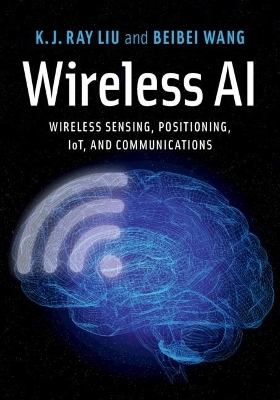
Wireless AI
Cambridge University Press (Verlag)
978-1-108-49786-2 (ISBN)
With this groundbreaking text, discover how wireless artificial intelligence (AI) can be used to determine position at centimeter level, sense motion and vital signs, and identify events and people. Using a highly innovative approach that employs existing wireless equipment and signal processing techniques to turn multipaths into virtual antennas, combined with the physical principle of time reversal and machine learning, it covers fundamental theory, extensive experimental results, and real practical use cases developed for products and applications. Topics explored include indoor positioning and tracking, wireless sensing and analytics, wireless power transfer and energy efficiency, 5G and next-generation communications, and the connection of large numbers of heterogeneous IoT devices of various bandwidths and capabilities. Demo videos accompanying the book online enhance understanding of these topics. Providing a unified framework for wireless AI, this is an excellent text for graduate students, researchers, and professionals working in wireless sensing, positioning, IoT, machine learning, signal processing and wireless communications.
K. J. Ray Liu is Christine Kim Eminent Professor of Information Technology in the Department of Electrical and Computer Engineering at the University of Maryland, College Park. A Highly Cited Researcher, he is a Fellow of the Institute of Electrical and Electronics Engineers (IEEE) and the American Association for the Advancement of Science (AAAS), IEEE Vice President, Technical Activities, and a former President of the IEEE Signal Processing Society. He is a recipient of the 2016 IEEE Leon K. Kirchmayer Award, the IEEE Signal Processing Society 2014 Society Award, and the IEEE Signal Processing Society 2009 Technical Achievement Award. He has also co-authored several books, including Cooperative Communications and Networking (Cambridge, 2008). Beibei Wang is Chief Scientist in Wireless at Origin Wireless, Inc., and is also affiliated with the University of Maryland. She has been a recipient of the Outstanding Graduate School Fellowship, the Future Faculty Fellowship, the Dean's Doctoral Research Award from the University of Maryland, and the Overview Paper Award from the IEEE Signal Processing Society in 2015. She has co-authored Cognitive Radio Networking and Security: A Game-Theoretic View with K. J. Ray Liu (Cambridge, 2010).
1. Principles of time reversal and effective bandwidth; Part I. Indoor Locationing and Tracking: 2. Centimeter-accuracy indoor positioning; 3. Multi-antenna approach; 4. Frequency hopping approach; 5. Decimeter-accuracy indoor tracking; Part II. Wireless Sensing and Analytics: 6. Wireless events detection; 7. Statistical learning for indoor monitoring; 8. Radio biometrics for human recognition; 9. Vital signs estimation and detection; 10. Wireless motion detection; 11. Device-free Speed estimation; Part III. Wireless Power Transfer and Energy Efficiency: 12. Time-reversal for energy efficiency; 13. Power waveforming; 14. Joint power waveforming and beamforming; Part IV. 5G Communications and Beyond: 15. Time-reversal division multiple access; 16. Combating strong-weak resonances in TRDMA; 17. Time-reversal massive multipath effect; 18. Waveforming; 19. Spatial focusing effect for networking; 20. Tunnelling effect for cloud radio access network; Part V. IoT Connections: 21. Time-reversal for IoT; 22. Heterogeneous connections for IoT.
| Erscheinungsdatum | 07.10.2019 |
|---|---|
| Zusatzinfo | Worked examples or Exercises |
| Verlagsort | Cambridge |
| Sprache | englisch |
| Maße | 178 x 253 mm |
| Gewicht | 1350 g |
| Themenwelt | Informatik ► Theorie / Studium ► Künstliche Intelligenz / Robotik |
| Technik ► Nachrichtentechnik | |
| ISBN-10 | 1-108-49786-1 / 1108497861 |
| ISBN-13 | 978-1-108-49786-2 / 9781108497862 |
| Zustand | Neuware |
| Informationen gemäß Produktsicherheitsverordnung (GPSR) | |
| Haben Sie eine Frage zum Produkt? |
aus dem Bereich


